The Future of Mobility: Transforming Transportation

Where is the Future We Were Promised?
Remember the Jetsons, that iconic animated series that promised us a futuristic utopia? Flying cars, robotic maids, and cities in the sky — it all seemed like an exciting, inevitable future. But here we are, decades later, still stuck in traffic, dealing with climate change, and questioning: Where is the future we were promised when we were young?
The Impact of Choices: A Look Back to Move Forward
As we reminisce about the dreams we were promised during our youth, we must examine the pivotal choices that have shaped our present reality. To gain insight into why our society does not mirror the futuristic vision of the Jetsons, we have to travel through time, tracing back to the origins of the mobility industry. These early choices, made with limited foresight, have profoundly influenced the trajectory of our society. Our exploration of this historical context serves as a foundation for understanding the complex interplay of decisions that have led us to our current state.
Our journey through time, especially in the field of the automobile, continues with the threads of our decisions. Each choice, investment, and innovation resonate across decades, influencing the trajectory of our civilisation.
In the late 1800s, cities faced crises due to horse-drawn vehicles' pollution and congestion. Electric cars emerged as a cleaner alternative, with models like the Electrobats operating in Manhattan.
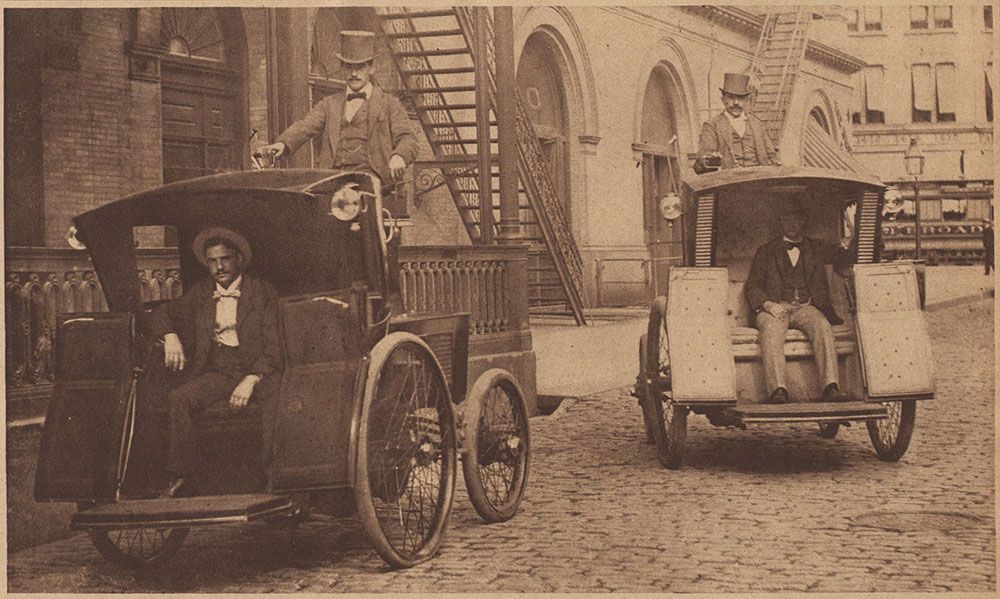
However, limitations like range and charging times hindered widespread adoption. The 20th century saw the dominance of combustion engines despite concerns about sustainability and reliance on oil. How could the world have looked if those first electric vehicles had survived and replaced the internal combustion engine?
With the rise of electric vehicles, we face new challenges, such as resource scarcity and managing personal mobility data, which appears to be a privacy nightmare. Our journey underscores the balance between innovation and unintended consequences, urging careful consideration as we navigate the future. It also shows that the decisions we make today will have long-term consequences.
As we fast forward to the present, it becomes abundantly clear that the interplay of our choices has sculpted our current mobility landscape, a complex mosaic of progress and challenges, promises fulfilled and dreams deferred.
A Globalised and Urbanised Reality Enabled by Mobility
So, let's examine the current state of mobility, shaped by decisions made a century ago. Our choices then have steered us to the contemporary landscape, where promises have materialised, and dreams have faced setbacks. Embracing globalisation and urbanisation, we find ourselves navigating a world intricately woven by past decisions, a tapestry of achievements and unmet aspirations.
Globalisation: Interconnected Horizons
Mobility has played a pivotal role in transforming the concept of a global village from a utopian ideal into a tangible reality. In the past, vast oceans and insurmountable distances separated nations, limiting international interactions. However, mobility innovations have intricately woven the world together through a global supply chain. Goods, ideas, and services now traverse borders with unparalleled ease, fostering international cooperation and cultural exchange.
This interconnectedness, facilitated by efficient transportation and communication systems, has ushered in an era of unprecedented access to products from around the globe. As a result, our lives have been enriched, and our perspectives have broadened, leading to a more interconnected and culturally diverse world.
Mobility, acting as the bridge between nations, has facilitated economic exchange and nurtured mutual understanding, tolerance, and cooperation among people from diverse backgrounds. The role of mobility in globalisation is fundamental, shaping a world where borders are no longer barriers and the exchange of goods, ideas, and cultures knows no bounds.
Urbanisation: Cities as Epicenters of Innovation
Urbanisation has transformed cities into vibrant hubs of innovation, culture, and economic activity. These metropolises are not just clusters of buildings but thriving centres where ideas collide and creativity flourishes. Urbanisation has catalysed the exchange of ideas, giving birth to technological advancements that shape our modern way of life.
Cities serve as epicentres where diverse minds converge, fostering unity among the human race. The magnetic pull of cities continues to attract individuals seeking opportunities and education, driving innovation and progress.
Mobility within cities has been a catalyst for this transformation, enabling the exchange of ideas and resources, connecting people and businesses, and facilitating collaboration. The role of mobility in urbanisation is pivotal, providing the arteries through which innovation flows and communities thrive.
Massive Economic Growth: Engines Fueled by Mobility Innovations
The numbers speak volumes, echoing the tale of unprecedented economic growth powered by mobility innovations. From the assembly lines of pioneering car manufacturers to the high-tech laboratories developing cutting-edge electric vehicles, mobility has been a catalyst for economic advancement.
Job creation, entrepreneurship, and investment opportunities have flourished in the wake of innovations in transportation. This economic growth, rooted in the mobility sector, has elevated individual lives and propelled nations towards prosperity, laying the foundation for a future where opportunities abound.
Confronting the Harsh Realities of Mobility
As we delve deeper into the intricacies of our past and present, it becomes evident that our choices have been both architects and sculptors of our world. The story of mobility, interwoven with the threads of globalisation, urbanisation, and economic growth, is a testament to human ingenuity and adaptability. Yet, even within these triumphs lie challenges that demand our attention — challenges that, when addressed with wisdom and innovation, can pave the way for a future where the promises of the Jetsons are not just the stuff of animated fantasies but tangible realities shaping the lives of generations to come.
Climate Change: The Warning Signs from the Past
In the historical archives of August 14, 1912, a modest New Zealand newspaper bore witness to a succinct yet pivotal article. This piece underscored the profound global consequences of coal consumption on our planet's temperature.
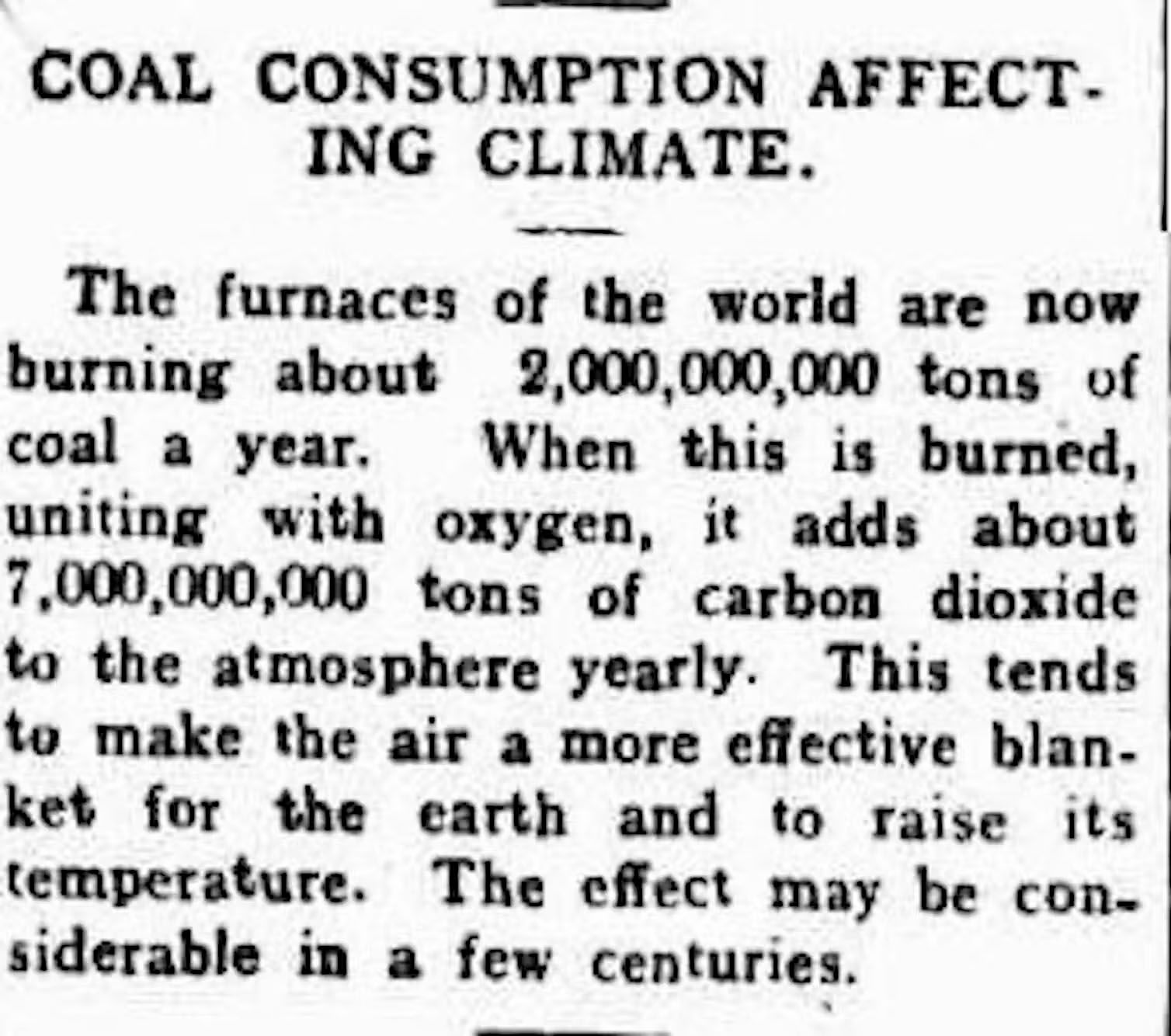
Mobility's historical choices and present impact are pivotal in climate change awareness. Early innovations like electric vehicles hinted at sustainability. Today, mobility illustrates the urgency of climate action, emphasising the consequences of past choices. Accessible eco-friendly transportation shapes public opinion and policy, fostering international cooperation. Recognising these lessons, embracing sustainable mobility, and promoting awareness are essential to combat climate change.
Human Cost: Lives Shattered and Dreams Deferred
In envisioning the future of mobility, the advent of autonomous vehicles stands as a beacon of hope amid the tragedy of preventable accidents. Today, road accidents claim 1.3 million lives annually, a grim reality demanding urgent action. Yet, emerging technologies herald a transformative era. Self-driving cars, propelled by AI, offer a profound shift—a potential 90% reduction in accidents, reshaping mobility into a realm of unprecedented safety.
Each statistic, a poignant reminder of lives lost, finds solace in the promise of autonomous mobility. No longer fleeting numbers, these lives guide the evolution of mobility solutions. Autonomous vehicles, free from human error, signify more than just innovation; they embody a collective commitment to shield families and communities from sorrow. With every autonomous mile travelled, a legacy of safety unfolds, ensuring that no journey leads to tragedy. This vision propels us toward a future where mobility isn't merely a mode of transport but a sanctuary of security—a testament to the potential of technology to preserve dreams and rewrite the narrative of human mobility.
Time Wasted: Economies Stuck in Traffic Jams
In the entangled chaos of traffic jams, we find ourselves trapped, losing billions of hours annually. Imagine a world where these hours aren't wasted but liberated, channelled into realms of productivity, innovation, and cherished moments. Mobility, often overlooked, emerges as the linchpin in this transformation.
Beyond mere inconvenience, traffic congestion stifles economic growth, squandering precious time that could fuel education, research, and creativity. Mobility, when optimised, transcends transportation—it becomes the catalyst liberating our most invaluable resource: time. Addressing this challenge isn't just about smoother traffic flow; it is a paradigm shift, unlocking the true economic potential of nations. In this future, mobility is the gateway to an era where time isn't a liability but an asset, propelling societies toward unparalleled progress and prosperity.
Confronting these harsh realities demands more than just acknowledgment; it requires a concerted, global effort. It necessitates reimagining our approach to mobility, integrating innovation with responsibility. By taking lessons from the past, understanding the present challenges, and envisioning a future where mobility is sustainable, safe, and efficient, we can transform these harsh realities into opportunities for progress. It is not a choice; it is a responsibility we owe to the generations that will inherit the consequences of our actions or inactions. The path ahead may be challenging, but within these challenges lie the seeds of transformative change, waiting to be nurtured by our collective will and determination.
Time's Standstill: The Paradox of Urban Mobility

Intriguingly, despite the leaps in automotive technology, the essence of urban mobility has remained remarkably unchanged over the past century. While cars have grown faster, the average speed at which people move within cities has shown surprising stagnation. A century ago, the hustle and bustle of city life propelled pedestrians and early automobiles at a pace not too dissimilar from today's urban crawl. For example, a 2021 Transport Australia Society Discussion Paper showed that the average travel speed in all cities surveyed declined in the past 20 years. Despite the promise of speedier vehicles, the intricate dance of city movement has resisted significant acceleration. This paradox challenges our assumptions, highlighting that progress in urban mobility is not merely about faster vehicles but demands innovative solutions that transcend the limitations of congested cityscapes.
The Data Revolution: Fueling the Future of Mobility
Transitioning from retrospection to anticipation, we venture into the uncharted territories of future mobility, driven by an array of groundbreaking technologies. In the ever-shifting landscape of societal progress, mobility stands as a cornerstone, shaping our cities, economies, and daily lives. Acknowledging the transformative power of mobility, we delve into the realm of possibilities, where innovation converges with human needs.
In the intricate tapestry of the future, data stands as the vital thread, weaving together the fabric of modern mobility. Much like how oil powered the industrial revolution, data fuels the transformation of transportation in the digital age. It is not merely a commodity; it is the lifeblood of innovation, propelling us toward a future where mobility is both a convenience and a sustainable, efficient, and seamless experience.
As we peer into the future of mobility, it is crucial to recognise that the decisions we make today will shape the trajectory of the next decades. Our ability to address the challenges on the horizon will determine whether our cities flourish or falter whether our environment thrives or suffers. Embracing long-termism and understanding that the repercussions of our choices echo through generations is paramount. In this context, let's delve into the pivotal challenges that await us and demand immediate attention, innovation, and collaborative solutions.
Challenges on the Horizon: Navigating the Next Decades
The challenges on the horizon encapsulate the multifaceted obstacles that define the future of urban mobility. Rapid urbanisation, technological advancements, and environmental concerns present a complex landscape that cities worldwide must navigate. Addressing these challenges is crucial for creating sustainable, efficient, and inclusive urban spaces. In this section, we delve into key areas demanding attention, exploring innovative solutions and collaborative efforts that pave the way for a transformative urban mobility landscape, such as:
- Sustainability: Pioneering Climate-Neutral Mobility
- Congestions: Overcoming the Urban Quagmire
- Outdated Infrastructure: Unearthing Opportunities
- Regulation: Navigating the Regulatory Landscape
- Behavioural Change: Shaping Mindsets for a New Era
In the face of these challenges, understanding the intricacies and interconnections becomes paramount. Let’s explore each challenge in depth, dissecting the complexities that define our future mobility landscape.
Sustainability: Pioneering Climate-Neutral Mobility
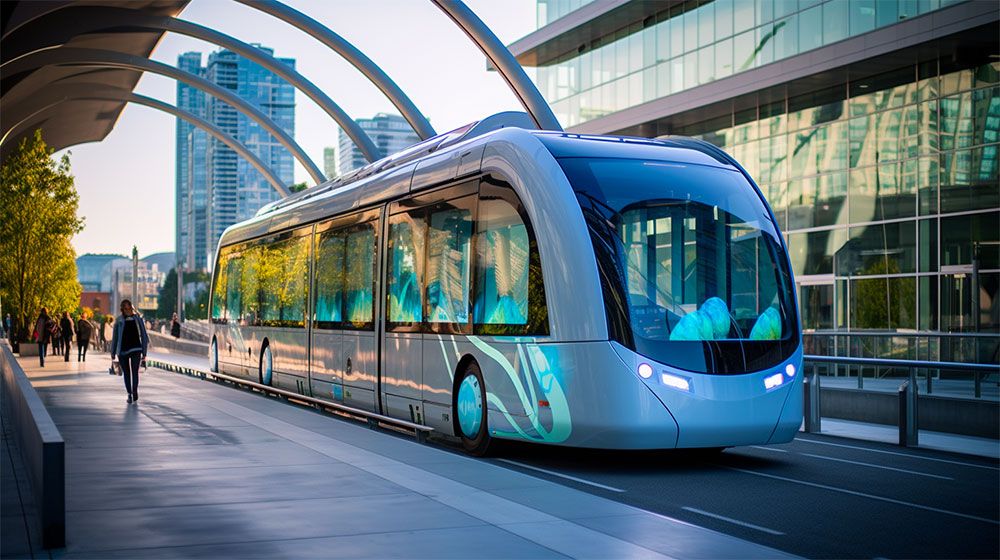
One of the foremost challenges of the future lies in transforming mobility into a force for environmental good. The imperative is not just climate neutrality but striving for climate-negative solutions. The transition to EVs is just the tip of the iceberg, and it is crucial to acknowledge that even with their environmental benefits, EVs take a considerable amount of time to break even in terms of carbon emissions.
As highlighted in a recent report by Forbes, high-mileage EVs may win the CO2 race, but the scenario shifts when considering low-use situations, favouring hybrids as a more immediate and practical solution. This underlines the complexity of our pursuit and emphasises the need for holistic strategies encompassing various technologies and usage scenarios to truly achieve climate-negative outcomes in mobility.
Electric flying and hydrogen-based transportation for trucks, ships, and planes represent the cutting edge of sustainable mobility. Take, for example, electric trucks by Tesla Semi, electric ships like the Yara Birkeland, and hydrogen-powered planes in development by several aerospace companies.
Changes to the infrastructure are equally crucial. Instead of merely upgrading roads, rethinking the very products that move on them is innovative. In cities like Amsterdam, cargo bikes have replaced delivery trucks, reducing congestion and emissions. Mobility hubs, where various transportation modes converge, are emerging globally, enabling seamless transitions between buses, bikes, and trains, effectively reducing the need for individual car usage.
Congestions: Overcoming the Urban Quagmire
Urban congestion, a symptom of our expanding cities, signifies more than just a traffic problem; it reflects a broader challenge: the efficiency of movement within our urban centres. As mentioned, despite technological advancements, the average speed of people moving within cities has seen minimal improvements and declines over the years. This stagnation underscores the intricate nature of urban mobility. It is not merely about reducing traffic jams but about reimagining our cities to facilitate swift, sustainable, and seamless movement for everyone. Addressing congestion isn't just a matter of untangling traffic; it is about enhancing the very fabric of urban living.
Mobility-as-a-Service (MaaS) platforms offer fully integrated, seamless transportation experiences via one app. Helsinki's Whim app is a prime example, allowing users to plan and pay for various modes of transport, promoting shared mobility and reducing congestion.
Micro-mobility solutions, such as electric bicycles and scooters, are transforming short-distance travel. Companies like Lime and Bird offer electric scooters that can be rented through apps, providing convenient, eco-friendly alternatives to traditional cars.
Outdated Infrastructure: Unearthing Opportunities
Outdated infrastructure poses a significant challenge, especially in countries like the USA, where aging systems are becoming increasingly apparent, but it also presents an opportunity for radical change.
The challenge lies in the vast scale and complexity of updating infrastructure that has existed for decades. For instance, a substantial portion of roads, bridges, and public transportation networks were built several decades ago in the United States. As these structures deteriorate over time, maintaining them becomes a pressing concern. Upgrading or replacing such infrastructure demands substantial financial investments and meticulous planning, coordination, and engineering expertise. Moreover, the process is often disruptive, impacting daily commutes and economic activities.
Despite the hurdles, addressing outdated infrastructure presents a unique opportunity for radical change, allowing cities and nations to embrace innovative technologies and sustainable practices, thereby shaping a more efficient, resilient, and connected urban future. For example, the opportunity could be grasped to transform cities into 15-minute cities, where essential services are within a 15-minute walk or bike ride. The movement is gaining rapid traction around the world. Paris has embraced this concept, redesigning urban spaces to prioritise local accessibility, reducing the need for long commutes.
The concept of 15-minute cities, where essential services are within a short walk or bike ride, offers numerous benefits, including reduced commute times, improved quality of life, economic growth, and environmental sustainability. However, achieving this vision requires extensive urban redesign, addressing outdated infrastructure, ensuring equitable access, and implementing effective policies and governance. Upgrading existing roads, utilities, and public transportation networks is crucial in making 15-minute cities a reality, as it demands substantial investments and innovative solutions to transform urban spaces and meet the needs of residents in the modern age.
Redesigning cities is a unique opportunity, especially when considering CAVs, which require less road space due to their efficient algorithms. Singapore has been testing autonomous buses, maximising road usage, and in San Francisco, autonomous taxis have gained approval, further advancing the integration of these vehicles into urban transportation systems. These developments signify a shift towards more streamlined, space-efficient, and innovative modes of city travel. Connectivity between modes of transportation, like integrating bike lanes and bus routes, provides more space for micro-mobility options, easing congestion on roads.
Regulation: Navigating the Regulatory Landscape
Regulation in urban mobility poses challenges due to the rapid pace of technological advancements. Adaptable frameworks are essential to accommodate innovations like autonomous vehicles, ride-sharing platforms and novel modes of (micro)transportation. Striking a balance between fostering innovation, ensuring safety, and promoting accessibility is key. Fortunately, there are numerous examples that show how this can be achieved:
- Public-Private Partnerships: Collaborations like Uber and Masabi in Denver streamline travel by integrating public transport ticketing into ride-sharing apps.
- Sustainability Incentives: Stockholm's congestion pricing system charges vehicles entering the city centre, encouraging public transport use and reducing emissions.
- Global Collaboration: Platforms like the International Transport Forum enable cities to share best practices, fostering effective regulations.
With adaptable frameworks, encouraging innovation, and fostering global collaboration, cities can shape regulations that support safer, more accessible, and sustainable urban mobility. Most importantly, regularly updating regulations based on technological advancements will ensure relevance and effectiveness in the evolving mobility landscape to accommodate the rapid pace of innovation.
Behavioural Change: Shaping Mindsets for a New Era
The advent of innovative modes of transportation demands a paradigm shift in how individuals perceive and engage with mobility. The pivot towards shared CAVs from personal modes of transportation epitomises this requisite change in mindset. The allure of personal vehicle ownership is often rooted in the bespoke convenience and comfort it offers. Transitioning to shared CAVs necessitates a replication of this personalisation to allure individuals towards shared mobility.
Personalisation within shared vehicles, regarding seat preferences, climate control, or entertainment options, can significantly mitigate the perceived loss of personal space and control, making shared mobility a more attractive proposition. This is where AI can help and offer each passenger a hyper-personalised experience. Moreover, purifiers and self-cleaning mechanisms in autonomous cars enhance passenger comfort.
Seamless integration between different modes of transportation, observed in countries like Japan with their integrated Suica card system, also promotes fluid travel experiences. Such integration fosters a more cohesive, user-friendly mobility ecosystem that can significantly contribute to changing mindsets towards new transportation modalities.
Dynamic pricing strategies, where the polluter pays more during rush hours, are being tested in cities like London, influencing behaviour by encouraging travel during off-peak times. Urban redesign initiatives, such as the 15-minute city concept and ambitious projects like NEOM and The Line in Saudi Arabia, are reshaping urban landscapes and fostering sustainable, accessible mobility.
Education plays a pivotal role in informing individuals of the impact their actions have on climate and mobility. Initiatives like Sweden’s Vision Zero educate citizens about road safety, reducing accidents, and promoting responsible driving habits.
As we navigate the intricate web of challenges and opportunities in the mobility landscape, these innovative solutions represent glimpses into a future where data-driven decisions, sustainable technologies, regulatory foresight, and societal adaptation converge. This convergence paints a picture of a future where mobility is not just a mode of transport but a gateway to a more interconnected, accessible, and eco-conscious world. The road ahead is challenging, but with each innovation, regulation, and change in behaviour, we inch closer to a mobility paradigm that truly serves humanity and our planet. This is, of course, where emerging technologies can help.
Looking Ahead: Technologies Shaping Mobility until 2050
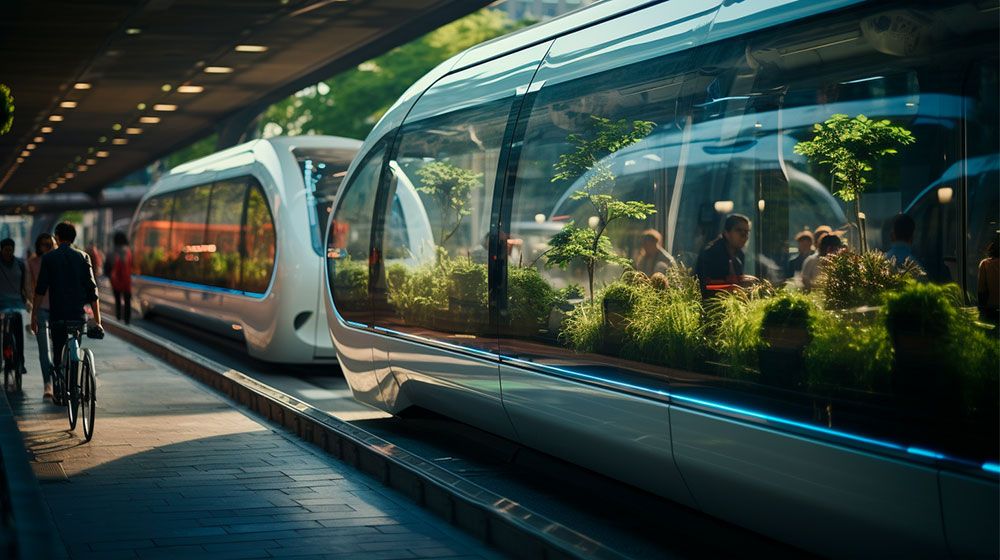
In the transformative landscape of urban mobility, technology serves as the catalyst for change, reshaping how we move, connect, and live. As we stand at the crossroads of innovation and sustainability, exploring the profound impact of technology on mobility becomes imperative. In this section, we dissect the pivotal role of four groundbreaking technologies — Artificial Intelligence, Robotics, Quantum Computing, and the Metaverse — in shaping the future of urban mobility.
Each of these pillars promises an evolution in transportation and represents a societal shift, where the way we perceive and experience mobility will be fundamentally transformed. As we unravel the impact of these pivotal technologies, we glimpse a future where mobility is not just a means of transportation but a catalyst for a more connected, sustainable, and inclusive world.
As a result, these technologies influence our present and hold the key to a mobility paradigm that aligns harmoniously with the needs of humanity and our planet. They herald a future where mobility transcends its current constraints, propelling us into an era of unprecedented accessibility, safety, and efficiency.
Machine Learning and Generative AI: Crafting Smarter Cities and Personalised Journeys
With its ability to process vast amounts of data and draw intelligent conclusions, AI is set to revolutionise mobility. In urban settings, AI algorithms can optimise traffic flow, reducing congestion and travel time. Smart traffic lights that adapt to traffic patterns, for instance, can significantly enhance the efficiency of city transportation networks. Moreover, AI-driven knowledge bases, such as Large Language Models (LLMs), can provide real-time information to commuters in a natural way, suggesting optimal routes and transportation modes and offering a personalised in-car experience, making daily journeys smoother and more efficient.
AI and Urban Mobility
AI-driven tools can also facilitate seamless communication and collaboration among researchers and students worldwide, fostering a global knowledge exchange that transcends geographical boundaries. The vast amount of data processed by AI can provide valuable insights into urban mobility patterns, which, in turn, can inform urban planning and infrastructure development, creating more efficient and sustainable urban mobility systems. As AI continues to evolve, the potential for enhancing both urban mobility and knowledge sharing in our cities is boundless, promising a future where information flows freely and cities operate seamlessly, creating a more connected and informed society.
The fusion of artistry and artificial intelligence is reshaping our vision for urban landscapes. Initiatives like BetterStreetsAI, led by innovator Zach Katz, utilise AI tools to transform ordinary streets into vibrant, people-centric spaces. Katz's creative approach involves using AI algorithms, particularly DALL-E, to visually reimagine streets, emphasising pedestrian areas and green spaces.
However, beyond artistic endeavours, AI is becoming an essential tool for urban planners, especially in climate-challenged regions like Australia. Dr Hank Haeusler, from the University [1] of New South Wales AI Institute, emphasises the critical role of nuanced AI technology in adapting cities to combat climate change. Addressing urgent issues like extreme weather events, heatwaves, and flooding, AI-driven tools analyse existing street conditions and propose interventions. These interventions might include increasing greenery, changing materials, or altering the layout to enhance cooling and mitigate flood risks.
Predictive modelling and adaptive traffic control[2] , powered by machine learning algorithms, are vital components of this approach. These algorithms predict traffic flows and inform adaptive traffic control systems by analysing vast datasets. Optimising traffic light timings in real-time alleviates congestion and reduces fuel consumption and emissions, fostering greener, more efficient cities. AI-enabled tools offer rapid insights, allowing planners to make informed decisions swiftly, ensuring our urban spaces are not only aesthetically pleasing but also sustainable and resilient in the face of climate challenges.
Finally, AI can also be used to monitor the quality of the road, as shown in Dubai:
Personalisation Through Large Language Models (LLMs)
LLMs are transforming in-car experiences. Geely Galaxy, among others, uses LLMs to create intuitive, personalised interactions between vehicles and passengers. Imagine a car that understands your preferences, adjusts the climate, selects music, and plans routes based on your past behaviour and current context. This level of personalisation enhances comfort and anticipates user needs, making every journey tailored and enjoyable.
Geely’s breakthrough in AI-driven language models reshapes urban mobility. Their innovation, integrated into the Galaxy L6, enables intuitive voice commands, transforming how we interact with vehicles. Beyond entertainment, this tech heralds the future of autonomous driving, where vehicles comprehend complex instructions, enhancing safety and convenience.
Collaborations with Ecarx and Baidu underscore an industry-wide trend: integrating Enhanced Representation through Knowledge Integration LLMs. This fusion of AI with urban data offers profound insights. City planners gain nuanced perspectives on transportation patterns, user behaviour, and urban development. These insights drive informed decisions, optimising infrastructure, public transport, and traffic management. Geely’s strides exemplify a transformative urban future where cities become intelligent, responsive, and tailored to residents' evolving needs.
The Metaverse: Redefining Design and Driving Experiences
The metaverse, the convergence of the digital and the physical world, introduces exciting possibilities for mobility. Augmented Reality (AR) applications can provide real-time navigation information directly onto a user’s field of vision, enhancing situational awareness and making travel more intuitive. Audi's concept car showcases this seamlessly integrated AR experience, making driving safer and more engaging and informative.
Digital twins, virtual replicas of physical objects or environments, enable detailed simulations. In the context of mobility, they can be used to model and optimise traffic flow, predict congestion, and design efficient transportation systems, leading to smoother and faster journeys for everyone.
The metaverse's integration with mobility goes beyond navigation enhancements. It fosters a sense of community by enabling virtual collaboration among commuters. Through shared virtual spaces, individuals can coordinate travel plans, reducing congestion and optimising routes collectively. This communal approach to mobility in the metaverse streamlines travel and promotes social connectivity, redefining urban commuting experiences.
The metaverse has eliminated geographical barriers in the automotive design process. Engineers and designers from different corners of the globe can collaborate in real time, exploring virtual prototypes, making instantaneous changes, and testing innovative features. Volvo Cars’ use of Varjo AR glasses exemplifies this collaboration, allowing experts to visualise and refine designs seamlessly, reducing the time and costs associated with physical prototyping.
Quantum Computing: Revolutionising Route Optimisation
From vehicle design to last-mile delivery, the precision and efficiency offered by quantum systems are reshaping transportation networks. According to McKinsey's analysis, the economic value of the automotive industry alone could range from $29 billion to $63 billion by 2035.
Quantum computing has cracked the code on previously insurmountable problems, notably the Traveling Salesman Problem, a classic conundrum in route planning. Quantum algorithms can find the most efficient route among a large number of destinations, leading to optimised transportation networks. By improving the efficiency of cities and transportation systems, quantum computing can significantly enhance average travel speeds, making journeys faster and more convenient for people around the world.
This breakthrough has immense implications for mobility, enabling algorithms to calculate the most efficient routes for vehicles, reducing travel time, energy consumption, and emissions. This optimisation is not just theoretical; it is a real-world application that promises to reshape how goods and people move, increasing efficiency and reducing environmental impact.
In a pioneering collaboration between Terra Quantum and Honda Research Institute Europe (HRI-EU), [3] quantum computing has converged with conventional algorithms to revolutionise emergency response strategies. This transformative approach, highlighted in the news, has paved the way for a quantum leap in emergency evacuations.
Taking the Traveling Salesman Problem one step further, quantum computing can change mobility by customising travel experiences, taking into consideration a wide variety of variables and preferences. Its rapid data processing will enable personalised routes tailored to individual preferences, traffic, and environmental conditions. This personalised approach ensures efficient and optimised journeys and a seamless travel experience that aligns with individual needs, reshaping the future of urban mobility.
The mobility sector, a field characterised by continuous innovation, is embracing quantum computing (QC) as a catalyst for its rapid evolution. As electric vehicles surge in popularity and innovative solutions like cutting-edge batteries and autonomous cars come to the fore, the industry is transforming faster than ever before. The advent of quantum computing promises to accelerate this revolution.
While widespread commercial quantum computing applications are estimated to be a few years away, mobility companies are already piloting applications. For instance, OEMs could simulate how changing vehicle component compositions affect performance. At the same time, quantum computing may enhance sensors' capabilities within autonomous driving, allowing instant decisions in the face of road obstacles.
Quantum computing holds the potential to significantly reduce travel time, energy consumption, and emissions, fundamentally transforming the landscape of mobility. The collaborative strides in quantum technologies thus mark a pivotal moment in emergency response and reshaping the future of global mobility.
Robotics: Transforming Every Vehicle into an Intelligent Agent
CAVs are essentially robots on wheels – robotics combined with advanced sensors and artificial intelligence. CAVs have the potential to drastically reduce accidents and congestion. These vehicles can communicate with each other and infrastructure, enabling coordinated movements that optimise traffic flow and enhance safety. With self-driving cars becoming commonplace, travel speeds could increase significantly as vehicles can travel closer together at higher speeds, reducing air resistance and time wasted in traffic.
CAVs: Robots on Wheels
CAVs can navigate complex urban environments autonomously. When communicating with each other and infrastructure, CAVs optimise traffic flow, reduce accidents, and ease congestion. The synergy of robotics and AI in CAVs transforms vehicles into intelligent agents, ensuring safer, more efficient transportation systems, and many researchers around the world are trying to understand how to make CAVs a reality.
Moreover, CAVs promote inclusivity by enhancing accessibility for individuals with limited mobility, offering newfound independence and freedom. As these self-driving vehicles become an integral part of urban transport systems, they pave the way for a future where mobility is not only efficient but also accessible and sustainable, transforming cities into interconnected hubs of innovation and convenience.
Drone Delivery: Revolutionising Logistics
Drones are changing the way goods are transported. They can navigate urban landscapes swiftly, making them ideal for last-mile deliveries. Cities are experimenting with drone delivery services, reducing road congestion and offering rapid, efficient delivery solutions. Reports like “The Moving World Report” from 2023 offer insights into cities pioneering drone delivery, showcasing its potential in transforming logistics and reducing the environmental impact of transportation.
Drone delivery is reshaping last-mile logistics, offering swift, efficient solutions. Due to drones' ability to navigate urban landscapes directly, they ensure fast deliveries and reduce the use of traditional vehicles. This improves customer satisfaction, minimises emissions, and eases traffic congestion, fostering cleaner, more efficient urban mobility.
Integrating drones into delivery networks enhances overall mobility options, creating a greener, more responsive urban environment. Ultimately, drone technology accelerates the transition towards sustainable, convenient, and eco-friendly urban transportation systems.
Digital Twins: Revolutionising Maintenance and Innovation
Digital twins are not mere replicas; they are dynamic simulations of vehicles. Engineers can test various scenarios, from extreme weather conditions to intricate traffic patterns, all within a virtual environment. By simulating these scenarios, engineers can innovate more rapidly, ensuring that new features are thoroughly tested before deployment. This innovation process accelerates the introduction of safer, more efficient vehicles, ushering in a new era of mobility.
Moreover, digital twins enable over-the-air software updates for vehicles. Just like updating your smartphone, cars, trucks, trains, and planes can receive software improvements remotely. This reduces downtime, enhances security, and ensures that vehicles always operate at their optimal capacity. Such updates improve performance, introduce new features, and enhance safety protocols, keeping vehicles on the cutting edge of technology.
In this intricate interplay of technology, data, and innovation, the future of mobility is not just a vision; it is a tangible, evolving reality. These advancements are not isolated; they converge, creating a holistic transformation that redefines how we move, design vehicles, and maintain transportation systems. Tesla, a trailblazer in this revolution, utilises cutting-edge digital twin technology to collect and analyse vast amounts of data.
This innovation, among others, propels us toward smarter, more sustainable, and personalised mobility experiences. It is a journey where the fusion of these technologies shapes a future that is not just efficient but also profoundly intelligent and responsive to the needs of individuals and society as a whole. This convergence of innovative technologies mirrors the ethos of companies like Tesla, contributing significantly to the evolution of mobility in the 21st century.
The Convergence of Technologies Will Define Mobility
In the coming decades, these technologies will converge, reshaping how we perceive and experience mobility. From AI-driven smart cities to self-driving vehicles, augmented reality navigation, and quantum-optimised transportation networks, the future of mobility promises increased speed and enhanced safety, efficiency, and accessibility.
The landscape of modern mobility is rapidly evolving, steering us toward a future where vehicles are not just modes of transport but intelligent, connected ecosystems. Imagine cars equipped with advanced software that scans surroundings for parking spaces or potential hazards, paving the way for full autonomy.
As we hurtle toward 2050, these innovations will not just transform how we travel; they will redefine the very essence of movement, bringing us closer to the Jetsonian future we once dreamed of, where the boundaries of time and space blur, and the world becomes more interconnected than ever before.
Moving Forward: Navigating the Road Ahead
The journey toward transforming mobility transcends borders, demanding a collective global effort to create sustainable, efficient, and inclusive transportation systems. Reflecting on the challenges discussed earlier, a strategic, technology-driven approach becomes paramount. Embracing innovative solutions and harnessing the potential of emerging technologies such as artificial intelligence, robotics, quantum computing, and the metaverse hold the key to overcoming these challenges on a global scale.
1. Investment in Sustainable Infrastructure: Globally, prioritising investments in sustainable transportation infrastructure is crucial. Universal strategies include expanding public transport networks, constructing dedicated cycling lanes, and implementing pedestrian-friendly urban designs. These initiatives alleviate congestion and offer diverse, eco-friendly mobility choices, laying the foundation for resilient, future-ready cities.
2. Promoting Electric Mobility: Encouraging the adoption of EVs must be a global initiative. Governments worldwide can incentivise EV purchases through financial benefits and tax reductions. Developing a robust charging infrastructure to overcome range anxiety and supporting local manufacturing of EVs and batteries are essential steps. As cities shift to electric mobility, they can significantly reduce carbon emissions and promote environmental sustainability.
3. Regulation and Integration: Establishing agile regulatory frameworks that accommodate emerging technologies is pivotal. Regulations must ensure safety standards while integrating informal transit systems into structured mobility frameworks. This integration enhances efficiency while preserving flexibility, creating a cohesive mobility network adaptable to changing technology and user behaviour.
4. Promoting Sustainable Practices: Global awareness campaigns are instrumental in fostering a culture of sustainable commuting. Education initiatives can encourage the use of public transport, cycling, and walking, reducing the carbon footprint of daily travel. By instilling eco-friendly habits, communities worldwide can contribute to preserving the environment and creating a greener, healthier planet.
In this global endeavour, the fusion of strategic investment, forward-thinking regulation, and innovative technologies paves the way for a future where mobility is not merely a convenience but a cornerstone of sustainable living. When we align our efforts on a global scale, we can create a world where urban mobility is efficient, inclusive, and environmentally responsible, transcending the challenges of today and shaping a brighter, interconnected future for all.
Navigating the Future of Global Mobility
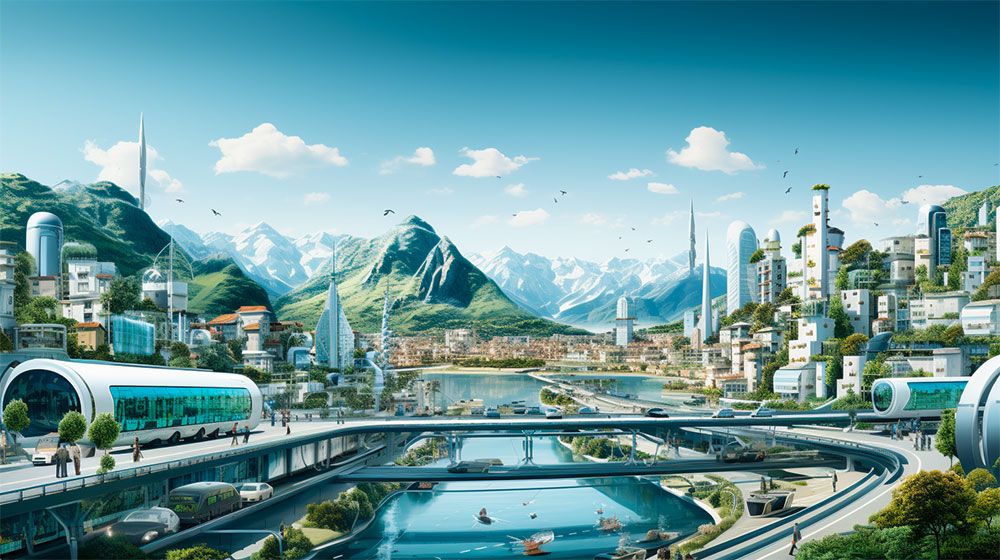
The global mobility landscape is undergoing a seismic shift, driven by technological advancements, environmental imperatives, and evolving societal needs. As we look ahead over the next 25, 50, and 75 years, several key trends and transformations are poised to reshape transportation globally.
In this sense, embracing the concept of long-termism becomes not just a choice but a necessity, especially in the realm of mobility, where projects are substantial, expensive, and time-consuming. Mobility initiatives, ranging from developing sustainable infrastructure to integrating cutting-edge technologies, require meticulous planning and significant investments, often taking years, if not decades, to complete.
Considering the extended timespans involved, adopting a forward-thinking approach that transcends immediate needs becomes imperative. Long-termism in mobility ensures that the solutions we implement today are viable, adaptable, and sustainable in the face of future challenges and generations.
The Next 25 Years: Building Sustainable Foundations
In the immediate future, the focus will be on building sustainable foundations for mobility. Cities worldwide will invest heavily in eco-friendly public transport, cycling infrastructure, and pedestrian-friendly urban designs. EVs will become more accessible and widespread, aided by incentives, and an extensive charging infrastructure will emerge. Additionally, regulatory frameworks will adapt, integrating innovative transit options and ensuring safety standards in autonomous and electric vehicles.
The Next 50 Years: Technological Integration and Smart Systems
Looking half a century ahead, technological integration will redefine how we move. Autonomous vehicles will become ubiquitous, reducing accidents, congestion, and emissions. Hyperloop systems and high-speed railways will connect cities, and autonomous hypersonic hydrogen passenger airplanes will make international travel faster and more efficient than ever before. Quantum computing could optimise traffic flow in real-time, minimising delays and enhancing safety. Urban centres will be characterised by smart infrastructure, where interconnected systems communicate seamlessly, providing real-time data for traffic management and predictive maintenance.
The Next 75 Years: Paradigm Shifts in Mobility
Seventy-five years from now, mobility will undergo paradigm shifts that we can hardly imagine today. Personalised air travel, powered by hydrogen and propelled by advanced propulsion systems, will offer unparalleled convenience. Space travel will become a commercial endeavour, connecting distant parts of the world and lower-orbit in mere hours. Environmental considerations will dominate, with transportation modes designed for minimal ecological impact. Advances in material science and energy storage will revolutionise vehicle design, leading to ultra-light, energy-efficient transportation solutions.
Conclusion: The Global Mobility Ecosystem
In this future landscape, sustainability, efficiency, and seamless integration will define the global mobility ecosystem. Transportation will be a service rather than a possession, accessible to all and optimised for individual needs. Mobility will be clean, intelligent, and interconnected, enabling people to travel effortlessly and sustainably.
The concepts of distance and time will be redefined, fostering a world where geographical boundaries blur and cultural exchange flourishes. In adopting innovation, fostering international collaboration, and prioritising environmental stewardship, the future of global mobility promises a world where the movement of people and goods is efficient and a force for positive change, connecting societies and shaping a brighter, more interconnected future for humanity.





